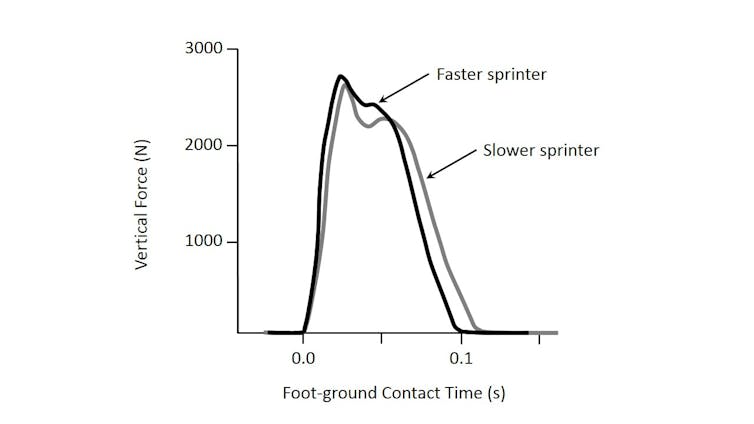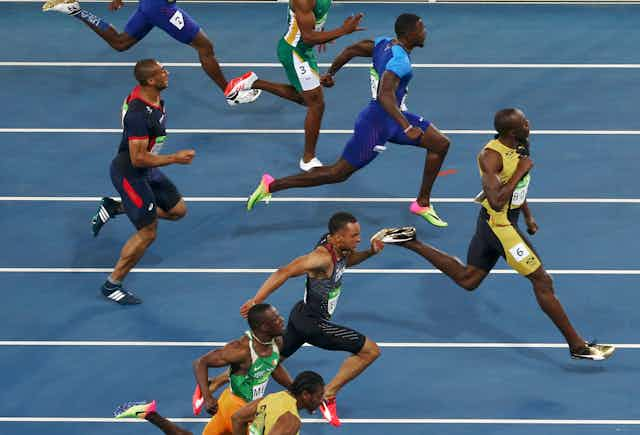In all sprint running races (100m to 400m), every hundredth of a second gained or lost in the race counts. But, most importantly, the fastest male and female sprinters attain incredible top running speeds, with peaks in excess of 44km per hour and 38km per hour in the men’s and women’s 100m races, for example. So what makes a fast runner?
The fastest sprinters on average take longer strides than slower sprinters, but at a similar stride rate. This results from larger forces being delivered to the ground in the short foot-ground contact period (often 0.1 second).
Of course, having longer legs can benefit stride length, which appears to be a significant reason for Usain Bolt’s superior top speed.
Generating force
In addition to improving stride length, the greater distance of the foot from the hip in taller sprinters allows a faster backwards horizontal foot speed to be attained for a given hip angular velocity, since the foot velocity (v) is a function of hip angular velocity (ω) and hip-foot distance (r); v = ωr.
But it’s not all good news for taller runners. Longer limbs have a greater moment of inertia (they’re harder to move), so they’re accelerated less for a given hip torque production (i.e. muscle force).
In this case, there are different costs-benefits for shorter versus taller sprinters; shorter sprinters must attain faster limb movement speeds, but taller sprinters need to generate sufficient torque to rapidly accelerate their longer limbs.
It’s also clear that rapid force production is paramount. Peak forces of more than 2500N (255kg) are delivered to the ground within a few hundredths of a second in each step.

If we continued to produce such rates of force for just one second, we could accelerate a Forumula 1 car to 100km per hour, or an 80kg athlete to about 900km per hour. Of course, peak force potential is limited in humans, so we won’t see this in Rio.
Muscular design
To deliver such forces, we might expect that sprinters possess a unique muscular design, and there is some evidence for this. Better sprinters have a high proportion of type II muscle fibres, which can develop forces so rapidly that they’re commonly called “fast twitch” fibres.
Further, some important power-producing muscles in their calf and thigh regions may possess longer muscle fibre bundles (which is thought to contribute to faster muscle-shortening speeds) attaching at smaller angles to the tendon than slower runners.

But, perhaps paradoxically, the best sprinters don’t have super-sized muscles.
One reason is that even the fastest muscles produce forces too slowly to allow humans to come close to the fast running speeds required, and increasing their size doesn’t help them produce forces any faster.
Instead, muscular forces stretch elastic tissues, such as tendons, and stored energy is subsequently recaptured at much faster rates when they recoil. Because of this, tendons work as “power amplifiers”.
However, we know little about the effect of changing tendon properties. We do know that sprint runners have stiffer Achilles tendons than non-runners. This should allow them to cope better with forces of over 900kg placed on the tendon and to recoil faster while under load during the propulsion phase of the foot-contact phase.
We also know that exercise such as strength training tends to increase their stiffness while detraining reduces it.
But we don’t yet know what the optimum stiffness is for the Achilles tendon (or other tendons), and we can’t yet set training programs to optimise them.

Getting a move on
Another issue is that increased muscle mass increases limb inertia (in much the same way as greater limb lengths do), so reducing the acceleration for a given joint torque production.
The best sprinters therefore have very low limb masses, which enables them to cyclically move their arms and legs at high speeds. So, the leanest sprinters may be the fastest.
Of final note is that sprinters must deliver their large forces to the ground in a very specific direction and with the least wasted energy. They spend years learning techniques that minimise unnecessary limb movements, particularly those in the frontal and transverse planes (those that are not in the direction of running).
The sprinters at the front in the finals will surely display better running techniques.
So while you might not be able to pick the fastest sprinters through muscle fibre type, fibre bundle length, or tendon stiffness tests, you can be sure their limb masses will be small and their techniques will be the most efficient. And after the races are over, perhaps we’ll be able to answer the final question: long legs or short?

